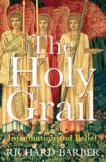Medieval Myth?
A man stands in a cave. Before him glitters an array of beautiful objects, some dishes or platters, but mostly cups. All are enticing, but only one is the object he seeks. He reaches out and grasps the plainest of all. That’s the cup of a carpenter, he avers. Has he chosen correctly? For readers of Richard Barber’s well-written and lavishly illustrated account of the medieval and modern re-imaginings of the so-called Holy Grail, the better question might be, why did the man think the object of his search should be a cup at all?
As Barber expertly shows, in recent centuries the Holy Grail has come to mean many things to many people, almost all of them overlaid with contemporary desires not necessarily traceable to a verifiable historical past. One of the most durable of these desires is that the Grail should be a physical, potentially archeologically recoverable thing, as it is in the scene from the film Indiana Jones and the Last Crusade (1989) referred to above. Even more frequently, if paradoxically, given its often vividly imagined materiality, the true Grail has been taken to exist only in the imagination as a perfect and therefore unattainable ideal. This is the form it takes in Charles Williams’s War in Heaven (1930), where the Grail represents something different to each of the main characters: family tradition, literary inspiration, religious experience at its best.
Barber, a British historian, charts all of these imaginative transformations from the late 18th-century rediscovery of the Arthurian stories in which the Grail legends are embedded to their modern re-enactments in opera, ritual and filmas over and again poets, artists and librettists, archeologists, novelists and neo-pagans have recast the Grail in the mold of their own desires. Such is the great strength of the imagination. The problem is that for the imagined artifact (the Grail) to work as a stimulus to further imagination (stories involving the Grail), it must on some level still be believed to beor to have at one time beenreal. And this is the one thing that for objectively inclined, agnostic historians like Barber, it is most certainly not.
Hence, arguably, the great poignancy of his book. This is not the book, he concludes, I expected to write when I started. Instead of recounting stories going back to pagan myth and shapes only dimly discernable in the remote past, Barber found himself writing a literary history that starts in the late 12th century, with the Arthurian romances of Chrétien de Troyes and a Grail that was not only clearly discernable, but ordinarily shaped: no chalice-like cup of a carpenter, but rather a mundane serving dish or graal.
What was this graal? Whom did it serve? These were the questions that Perceval, the protagonist of Chrétien’s story, should have asked, but didn’t, as he sat at the banquet of the wounded father of the Fisher King. Hard as it is for modern readers, accustomed to think of the Grail and its service as the center of the story, from Chrétien’s perspective the real mystery was this: Why did Perceval fail to speak? The graal, by contrast, was a holy thing, not because there was anything particularly mysterious about it, but because it bore the host that sustained the king.
For Chrétien’s contemporary admirers and succeeding ones, nevertheless, that it bore the host was mystery enough, for this was the greatest mystery they encountered in their daily lives: the transubstantiation of the bread and wine into the body and blood of Christ, by which not only tongue-tied knights and wounded kings, but humanity itself had been redeemed. Anything associated with this mystery, even something as prosaic as a serving dish, was grist for further speculation. As Barber shows, within 50 years of Chrétien’s writing, the graal of the Fisher King had been transformed into the vessel on which Christ broke bread at the Last Supper, which Joseph of Arimathea then used to collect the blood flowing from Christ’s wounds after his body was taken from the cross.
Later storytellers added further details: the Grail could be seen only by a knight who was physically and spiritually pure; it might take the form of a precious stone or chalice; it had powers not only to feed, but also to heal. By the time Sir Thomas Malory took up the story in the late 15th century, the Grail had quite literally taken on a life of its own, independent of the stories within which it had originally been imagined. And yet, curiously, it remained an object that no one living claimed ever to have seen. There is no medieval tradition of the Grail as a physical relic.
This, historically speaking, is the real mystery of the Grail: what began as a literary image with a clear Christian origin has become, over the past two centuries, at once an object to be sought (Indiana-Jones style) as a material witness to the reality of faith, and a self-sacred cult object that those opposed to the traditional structures of Christianity can use to escape into a world where everything has a voice. Spiritually speaking, this is also, arguably, its great irony, as Barber shows so well. First imagined as a serving platter for the body of the incarnate King, it has since been taken up as a symbol for that truth which many, including Barber, now fear it is vain to seek.
This article also appeared in print, under the headline “Medieval Myth?,” in the December 13, 2004, issue.








